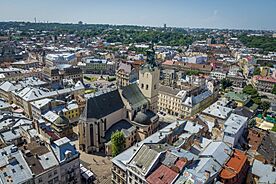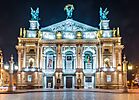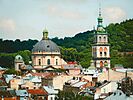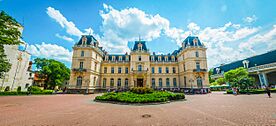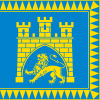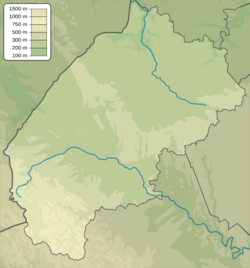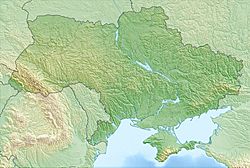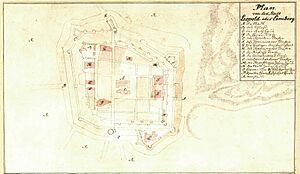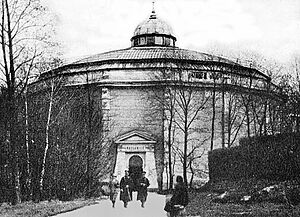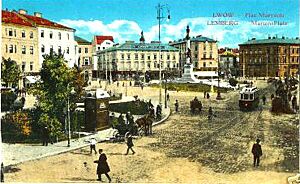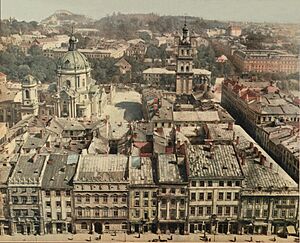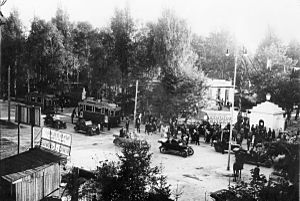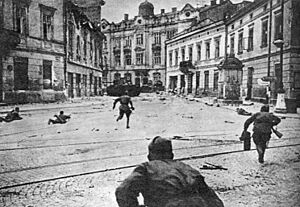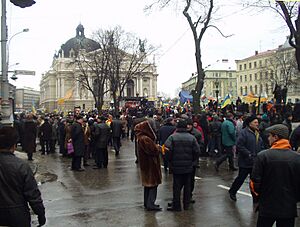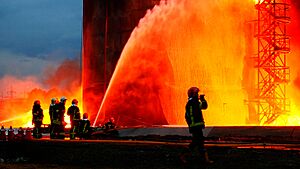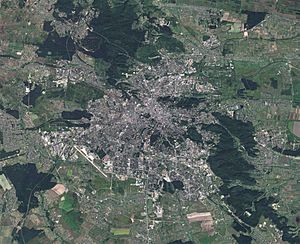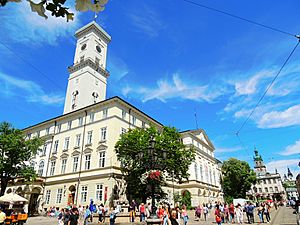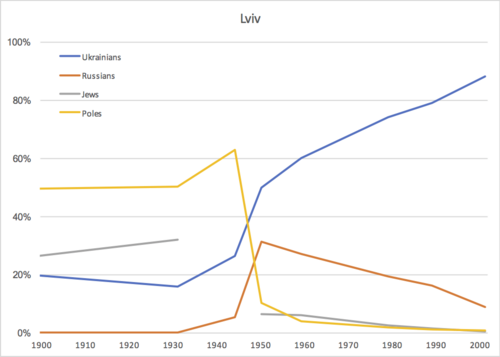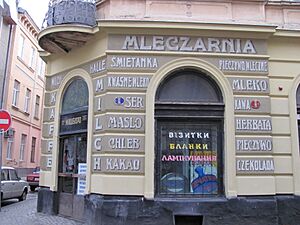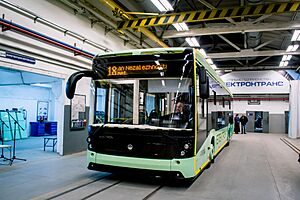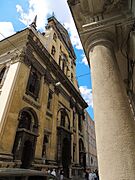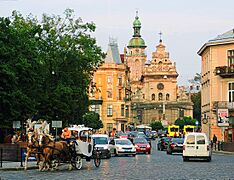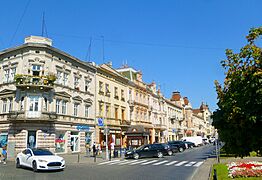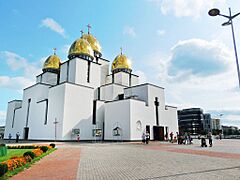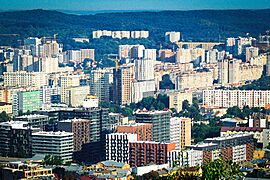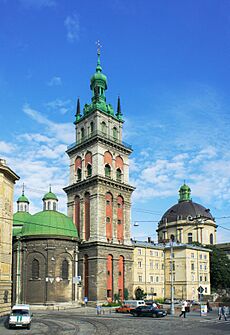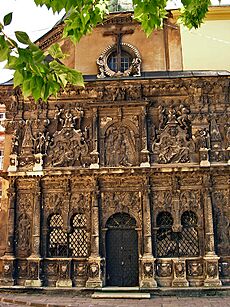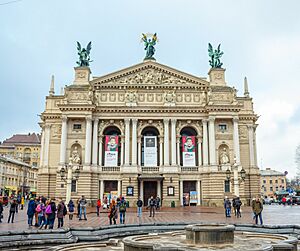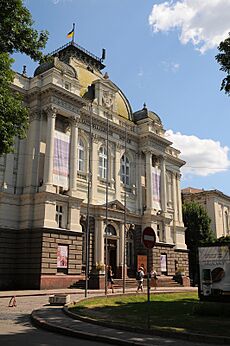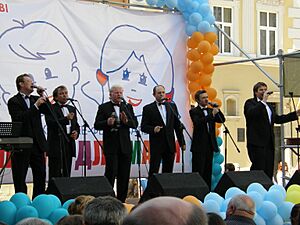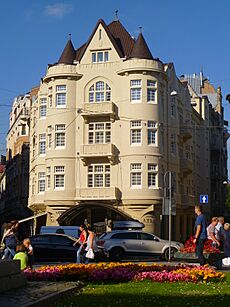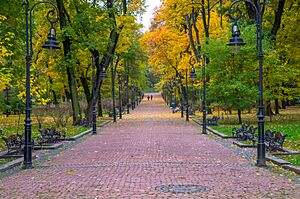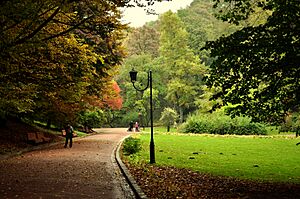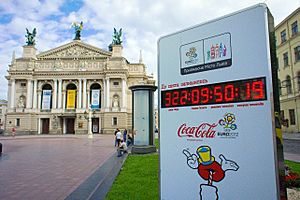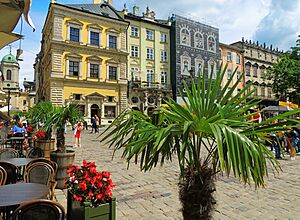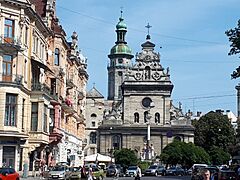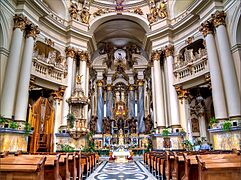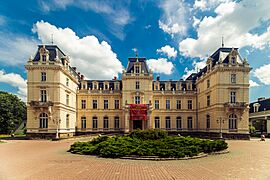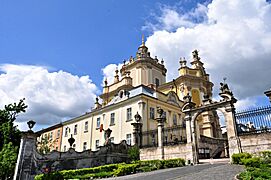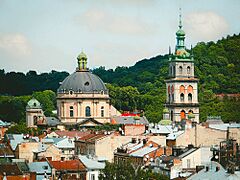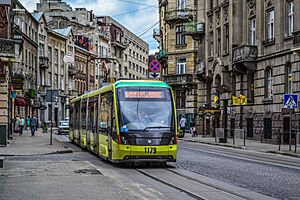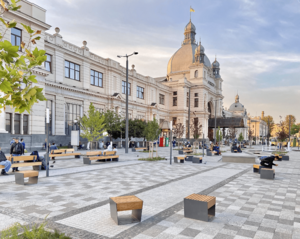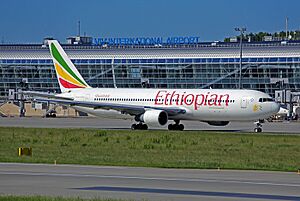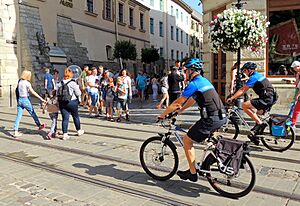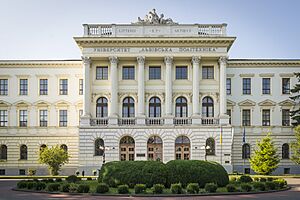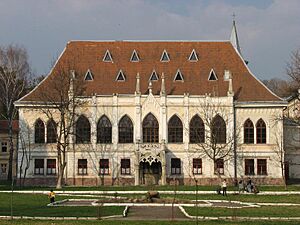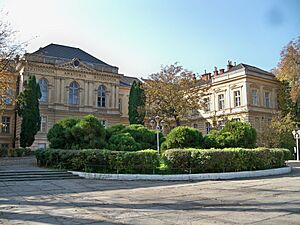Lviv facts for kids
Quick facts for kids
Lviv
|
|||||
|---|---|---|---|---|---|
|
City
|
|||||
|
Historic Centre of Lviv
Lviv Theatre
Dormition Church
Sts. O. and E. Church
Market Square
Potocki Palace
|
|||||
|
|||||
| Motto(s):
"Lviv is open to the world"
"Semper fidelis" |
|||||
| Country | |||||
| Oblast | Lviv Oblast | ||||
| Raion | Lviv Raion | ||||
| Hromada | Lviv urban hromada | ||||
| Founded | 1256 | ||||
| Town rights | 1356 | ||||
| Area | |||||
| • City | 148.9 km2 (57.5 sq mi) | ||||
| • Metro | 4,975 km2 (1,921 sq mi) | ||||
| Elevation | 296 m (971 ft) | ||||
| Population
(2022)
|
|||||
| • City | 717,273 | ||||
| • Rank | 6th in Ukraine | ||||
| • Density | 4,817.1/km2 (12,476/sq mi) | ||||
| • Metro | 1,141,119 | ||||
| • Demonym | Leopolitan | ||||
| Time zone | UTC+2 (EET) | ||||
| • Summer (DST) | UTC+3 (EEST) | ||||
| Postal codes |
79000–79490
|
||||
| Area code(s) | +380 32(2) | ||||
| Licence plate | BC, HC (before 2004: ТА, ТВ, ТН, ТС) | ||||
| Website | |||||
| UNESCO World Heritage Site | |||||
| Official name | L'viv – the Ensemble of the Historic Centre | ||||
| Criteria | Cultural: ii, v | ||||
| Inscription | 1998 (22nd Session) | ||||
| Endangered | 2023–present | ||||
| Area | 2,441 ha | ||||
Lviv (pronounced luh-VEEV) is a large and important city in western Ukraine. It is the fifth-largest city in Ukraine, with a population of about 717,500 people. Lviv is the main city of the Lviv Oblast region and is known as a major cultural center of Ukraine. The city was named after Leo I of Galicia, the son of Daniel of Galicia, who was a king.
Lviv became a key city in the regions of Red Ruthenia and Galicia in the 14th century. It was the capital of the Kingdom of Galicia–Volhynia from 1272 to 1340. In 1356, it was granted special town rights. For many years, it was an important regional capital within the Kingdom of Poland. Later, it became the capital of a region under the Habsburg Empire.
Between World War I and World War II, Lviv was part of the Second Polish Republic. It was a thriving center for culture, industry, and learning, with famous schools like the Lwów School of Mathematics. After the German-Soviet invasion of Poland in 1939, Lviv was taken over by the Soviet Union.
During World War II, the city's large Jewish community suffered terribly. Many people were killed or forced to leave their homes. After the war, most of the Polish population also moved away.
The historic heart of Lviv, with its old streets and beautiful buildings from different time periods, survived World War II mostly unharmed. This historic city center is now a UNESCO World Heritage Site. However, it has been listed as an endangered site because of the Russian invasion of Ukraine. In 1991, Lviv became part of independent Ukraine.
Today, Lviv is home to many industries and important universities, like Lviv University and Lviv Polytechnic. It also has many cultural places, including a philharmonic orchestra and the Lviv Theatre of Opera and Ballet.
Contents
City Names and Symbols
The city of Lviv has been known by different names throughout history. These include Lwów in Polish, Lemberg in German, and Lvov in Russian.
Lviv's official symbols are its coat of arms, the flag of the Lviv City Council, and its logo. Important buildings and historical places are also seen as symbols of the city.
Lviv's modern coat of arms shows a stone gate with three towers and a golden lion walking through the opening. This design comes from a city seal from the mid-14th century. The larger coat of arms has a silver crown and is held by a lion and an ancient warrior.
The city's flag is a blue square banner with the city's emblem and yellow and blue triangles on the edges.
Lviv's logo shows five colorful towers and the slogan "Lviv — open to the world." The Latin phrase Semper fidelis (meaning 'Always faithful') was used as a motto in the past.
Lviv's History
![]() Kingdom of Galicia–Volhynia c. 1250–1340
Kingdom of Galicia–Volhynia c. 1250–1340
![]() Kingdom of Poland 1340–1569
Kingdom of Poland 1340–1569
![]() Poland (First Republic) 1569–1772
Poland (First Republic) 1569–1772
![]() Austria/A-H Empire 1772–1918
Austria/A-H Empire 1772–1918
![]() Poland (Second Republic) 1918–1939
Poland (Second Republic) 1918–1939
![]() Soviet Union (Ukrainian SSR) 1939–1941 (occupation)
Soviet Union (Ukrainian SSR) 1939–1941 (occupation)
![]() Nazi Germany 1941–1944 (occupation)
Nazi Germany 1941–1944 (occupation)
![]() Soviet Union (Ukrainian SSR) 1944–1991
Soviet Union (Ukrainian SSR) 1944–1991
![]() Ukraine 1991–present
Ukraine 1991–present
Archaeologists have found that people lived in the Lviv area as early as the fifth century. The city of Lviv was founded in 1250 by King Daniel of Galicia. He named it Lvihorod in honor of his son, Lev I of Galicia.
Lviv was attacked by the Mongols in 1261. Some sources say the castle was destroyed, while others say the whole town was leveled. All agree it was ordered by the Mongol general Burundai.
After Daniel's death, King Lev rebuilt the town around 1270. He made Lviv his home and the capital of Galicia-Volhynia. In the 13th and early 14th centuries, Lviv was mostly a wooden city. It had a few stone churches, some of which still exist today, though they have been rebuilt.
Wars and Changes
During wars over the Galicia-Volhynia region in 1339, King Casimir III the Great of Poland took over Lviv. He burned down the old princely castle. Poland gained control of Lviv and the surrounding area in 1349. From then on, people tried to make the population more Polish and Catholic.
Casimir built a new city center with walls and a stone castle. The old settlement became known as the Krakovian Suburb.
Under Polish Rule
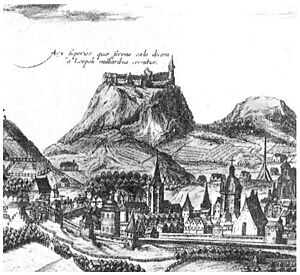
In 1349, the Kingdom of Ruthenia, with Lviv as its capital, became part of the Crown of the Kingdom of Poland. On June 17, 1356, King Casimir III the Great moved the city to a new spot and gave it special town rights. This meant that wealthy citizens could elect a council to manage city matters. In 1362, the High Castle was completely rebuilt with stone.
Lviv grew wealthy over the centuries because of trade rights given by Polish kings. Many Germans, Poles, and Czechs moved to the city. By the late 15th century, most settlers had adopted Polish culture. Lviv became a Polish city surrounded by Orthodox people.
In 1434, the region became the Ruthenian Voivodeship. In 1444, Lviv gained the right to be a "staple city." This meant all goods passing through had to be sold there, making it a major trading hub. It also became one of Poland's main fortresses. By the 17th century, Lviv was the second-largest city in the Polish–Lithuanian Commonwealth, with about 30,000 people.
In 1572, Ivan Fedorov, one of the first book publishers in what is now Ukraine, settled in Lviv. The city became an important center for Eastern Orthodoxy. A Jesuit school was founded in 1608, which later became a university in 1661.
The 17th century brought many armies to Lviv, including Swedes, Hungarians, Ottomans, Russians, and Cossacks. In 1648, an army of Cossacks and Crimean Tatars surrounded the town. They captured the High Castle but did not sack the city because their leader, Bohdan Khmelnytsky, accepted a large payment. Lviv was one of only two major Polish cities not captured during this time.
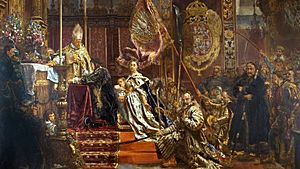
In 1656, King John II Casimir made a famous oath in Lviv's Cathedral, placing the Commonwealth under the protection of the Blessed Virgin Mary.
In 1672, the Ottomans tried to conquer Lviv but failed. Three years later, a battle took place near the city. Lviv was first captured by a foreign army since the Middle Ages in 1704, when Swedish troops entered after a short siege. A plague in the early 18th century killed about 10,000 people, which was 40% of the city's population.
Under Habsburg Rule
In 1772, after Poland was divided, Lviv became part of the Habsburg monarchy. It was known as Lemberg in German and became the capital of the Kingdom of Galicia and Lodomeria. Lemberg grew a lot in the 19th century, from about 30,000 people in 1772 to 212,000 by 1913. Many Austrians and German-speaking people moved there, giving the city an Austrian feel.
Under Habsburg rule, Lviv became an important cultural center for Poles, Ukrainians, and Jews. In 1910, about 51% of the city's population was Roman Catholic, 28% Jewish, and 19% Ukrainian Greek Catholic. Most people (86%) spoke Polish, and 11% spoke Ruthenian (Ukrainian).
In 1773, the first newspaper in Lemberg was published. In 1784, a university was opened. Over time, the language of teaching at the university changed to include Ukrainian and Polish. In 1853, kerosene lamps were first used for street lighting in Lviv. These were later replaced by gas lamps and then electric lights.
After 1867, Galicia became an autonomous province of Austria-Hungary. Polish and Ruthenian became official languages. Lviv grew quickly, becoming the fourth-largest city in Austria-Hungary by 1910. Many beautiful public buildings and homes were built during this time, like the Lviv Theatre of Opera and Ballet.
Lviv was home to many famous Polish institutions, including the Ossolineum library, which had one of the largest collections of Polish books. It was also a center for Polish independence groups.
At the same time, Lviv was a key city for Ukrainian cultural revival. Famous Ukrainian writers published their works there. It had the largest Ukrainian institutions in the world, like the Prosvita society, which helped spread literacy in Ukrainian.
Lviv was also a major center of Jewish culture and the Yiddish language. The world's first Yiddish-language daily newspaper started there in 1904.
First World War
During the First World War, Lviv was captured by the Russian army in September 1914. It was retaken by Austria-Hungary in June 1915. The city and its people suffered greatly during the war due to the fighting.
Polish–Ukrainian War
After the end of World War I, Lviv became a battleground between local Polish and Ukrainian groups. Both sides wanted the city to be part of their new countries. On November 1, 1918, the West Ukrainian People's Republic was declared with Lviv as its capital. Ukrainian soldiers tried to take over the city. However, the Polish majority in the city fought back, including young Polish defenders called Lwów Eaglets.
The Ukrainian forces left Lviv by November 21, 1918. Polish soldiers then looted and burned parts of the Jewish and Ukrainian areas, and some civilians were killed. The Ukrainian forces then surrounded the city. Polish forces, helped by troops from central Poland, relieved the city in May 1919. The Polish–Ukrainian War continued until July 1919.
In August 1920, Lviv was attacked by the Red Army during the Polish–Soviet War, but the city successfully defended itself. For its bravery, Lviv was awarded a special military cross. In 1923, the region was officially recognized as part of Poland.
Between the World Wars
Between the two World Wars, Lwów was Poland's third-largest city and a very important cultural and academic center. For example, in 1920, a professor developed a vaccine against typhus fever there. Lviv also played a key role in international trade. In 1937–1938, over 9,000 students attended five universities, including Lviv University and the Lviv Polytechnic.
About two-thirds of the city's people were Poles, and many spoke a special Lwów dialect. The Polish government focused on showing the city's Polish identity. Pre-war Lwów also had a large and active Jewish community, making up about a quarter of the population.
World War II and Soviet Control
German Occupation
On June 22, 1941, Nazi Germany invaded the USSR, and Lviv was taken by the Germans. During their occupation, the Germans committed many terrible acts. The Jewish population was forced into the Lwów Ghetto and the Janowska concentration camp was set up. Most of the Jewish people in Lviv were killed during this time. The Nazis also destroyed the Jewish cemetery.
The "Tango of Death" was a name given to an orchestra of prisoners in the Janowska concentration camp. They were forced to play music during terrible events. By the end of the war, almost all of Lviv's Jewish population was gone.
Soviet Re-occupation
In July 1944, the Soviet Red Army captured Lviv again. Polish resistance fighters helped them. However, Soviet forces then arrested Polish leaders. In 1945, the Allied leaders decided that Lviv would remain part of the Soviet Union, despite Polish objections.
Soviet Era
In February 1946, Lviv officially became part of the Soviet Union. Many Poles were moved from the city to other parts of Poland. Lviv lost a large part of its pre-war population. People from other parts of Ukraine and the Soviet Union moved in, changing the city's ethnic makeup.
During the 1950s and 1960s, Lviv grew quickly as new industries were developed. The city became a major center for movements that wanted Ukraine to be independent from the Soviet Union. By the time the Soviet Union fell in 1991, Lviv was a proud symbol of Ukrainian independence.
Independent Ukraine
Lviv citizens strongly supported Viktor Yushchenko during the 2004 Ukrainian presidential election and played a key role in the Orange Revolution. Many people gathered to protest for change. Lviv remains one of the main centers of Ukrainian culture and politics.
In 2014, Lviv's leaders declared themselves independent of President Viktor Yanukovych during the Euromaidan movement. In 2019, Lviv citizens strongly supported Petro Poroshenko in the presidential election, with over 90% of votes for him, though he lost nationally.
Since July 2020, Lviv has been part of the newly formed Lviv Raion, as part of Ukraine's administrative reforms.
Russian Invasion of Ukraine
During the Russian invasion of Ukraine that began in February 2022, Lviv became a key western hub. Some embassies and government agencies moved there from Kyiv for safety. Lviv also became a safe place for Ukrainians fleeing other war-affected areas, with over 200,000 people arriving by March 2022. Many used the city as a stop before going to Poland. Lviv and its region also served as important routes for arms and humanitarian aid. To protect its cultural heritage, the city's government and citizens worked to shield historical monuments and art.
Lviv and its surroundings have been hit by Russian missile attacks. The Yavoriv military training base was struck in March 2022, and a fuel depot and other facilities within the city were hit later that month. In April 2022, five missile strikes hit the city, killing seven civilians and wounding 11. Targets included military factories and a tire shop. A hotel housing evacuees was also damaged.
Lviv was also targeted during missile strikes in October 2022, causing a city-wide blackout and water supply issues.
Geography of Lviv
Lviv is located on the edge of the Roztochia Upland, about 70 kilometers (43 miles) east of the Polish border. It is also about 160 kilometers (99 miles) north of the eastern Carpathian Mountains. The city's average height is 296 meters (971 feet) above sea level. The highest point is the Vysokyi Zamok (High Castle), which is 409 meters (1,342 feet) above sea level. From this castle, you can see the historic city center with its unique churches and buildings.
The old walled city was built at the foot of the High Castle, along the Poltva River. In the 13th century, the river was used to transport goods. In the early 20th century, parts of the Poltva River that flow through the city were covered over. The river now flows directly beneath Lviv's central street, Liberty Avenue, and the Lviv Theatre of Opera and Ballet.
Lviv's Climate
Lviv has a humid continental climate with cold winters and warm summers. The average temperature in January is -3°C (27°F) and in July it is 18°C (64°F). The city gets about 745 millimeters (29.3 inches) of rain each year, with most of it falling in the summer. Lviv gets about 1,804 hours of sunshine per year.
| Climate data for Lviv (1991–2020, extremes 1936–present) | |||||||||||||
|---|---|---|---|---|---|---|---|---|---|---|---|---|---|
| Month | Jan | Feb | Mar | Apr | May | Jun | Jul | Aug | Sep | Oct | Nov | Dec | Year |
| Record high °C (°F) | 14.9 (58.8) |
17.9 (64.2) |
23.5 (74.3) |
28.9 (84.0) |
32.2 (90.0) |
34.1 (93.4) |
36.3 (97.3) |
35.6 (96.1) |
34.5 (94.1) |
25.6 (78.1) |
21.6 (70.9) |
16.5 (61.7) |
36.3 (97.3) |
| Mean daily maximum °C (°F) | 0.2 (32.4) |
2.0 (35.6) |
7.0 (44.6) |
14.5 (58.1) |
19.5 (67.1) |
23.0 (73.4) |
24.7 (76.5) |
24.5 (76.1) |
19.0 (66.2) |
13.2 (55.8) |
6.8 (44.2) |
1.5 (34.7) |
13.0 (55.4) |
| Daily mean °C (°F) | −2.7 (27.1) |
−1.5 (29.3) |
2.5 (36.5) |
9.0 (48.2) |
13.8 (56.8) |
17.3 (63.1) |
19.0 (66.2) |
18.5 (65.3) |
13.5 (56.3) |
8.4 (47.1) |
3.3 (37.9) |
−1.3 (29.7) |
8.3 (46.9) |
| Mean daily minimum °C (°F) | −5.7 (21.7) |
−4.8 (23.4) |
−1.4 (29.5) |
3.8 (38.8) |
8.4 (47.1) |
12.0 (53.6) |
13.7 (56.7) |
13.2 (55.8) |
8.7 (47.7) |
4.4 (39.9) |
0.4 (32.7) |
−4.1 (24.6) |
4.1 (39.4) |
| Record low °C (°F) | −28.5 (−19.3) |
−29.5 (−21.1) |
−25.0 (−13.0) |
−12.1 (10.2) |
−5.0 (23.0) |
0.5 (32.9) |
4.5 (40.1) |
2.6 (36.7) |
−3.0 (26.6) |
−13.2 (8.2) |
−17.6 (0.3) |
−25.6 (−14.1) |
−29.5 (−21.1) |
| Average precipitation mm (inches) | 46 (1.8) |
48 (1.9) |
48 (1.9) |
52 (2.0) |
93 (3.7) |
86 (3.4) |
96 (3.8) |
73 (2.9) |
70 (2.8) |
57 (2.2) |
50 (2.0) |
50 (2.0) |
769 (30.3) |
| Average extreme snow depth cm (inches) | 7 (2.8) |
9 (3.5) |
4 (1.6) |
0 (0) |
0 (0) |
0 (0) |
0 (0) |
0 (0) |
0 (0) |
0 (0) |
1 (0.4) |
4 (1.6) |
9 (3.5) |
| Average rainy days | 9 | 9 | 11 | 14 | 16 | 17 | 16 | 14 | 14 | 14 | 13 | 11 | 158 |
| Average snowy days | 17 | 17 | 11 | 3 | 0.1 | 0 | 0 | 0 | 0 | 1 | 8 | 15 | 72 |
| Average relative humidity (%) | 83.3 | 80.7 | 74.5 | 67.1 | 70.4 | 72.6 | 74.1 | 74.3 | 78.2 | 80.3 | 84.4 | 85.0 | 77.1 |
| Mean monthly sunshine hours | 64 | 79 | 112 | 188 | 227 | 238 | 254 | 222 | 179 | 148 | 56 | 37 | 1,804 |
| Source 1: Pogoda.ru.net | |||||||||||||
| Source 2: NOAA (humidity 1991–2020, sun 1961–1990) | |||||||||||||
City Districts
Lviv is divided into six main areas called urban districts (raions). Each district has its own local government.
- Halytskyi District is named after Daniel of Galicia.
- Zaliznychnyi District means "railway neighborhood."
- Lychakivskyi District
- Sykhivskyi District
- Frankivskyi District is named after Ivan Franko.
- Shevchenkivskyi District is named after Taras Shevchenko.
Some notable areas outside the main city include Vynnyky, Briukhovychi, and Rudno.
People of Lviv
Lviv residents live for about 75 years on average. This is longer than the average in Ukraine. In 2010, men lived to about 71 years, and women to 79.5 years. The number of births increased between 2001 and 2010. However, there are fewer young people under 25. In 2011, 13.7% of Lviv's population was under 15, and 17.6% were 60 or older.
Historical Population Changes
| Population structure by religion 1869–1931 | ||||||
|---|---|---|---|---|---|---|
| Community | 1869 | 1890 | 1900 | 1910 | 1921 | 1931 |
| Roman Catholic | 53.1% | 52.6% | 51.7% | 51% | 51% | 50.4% |
| Jewish | 30.6% | 28.2% | 27.7% | 28% | 35% | 31.9% |
| Greek Catholic | 14.2% | 17.1% | 18.3% | 19% | 12% | 15.9% |
| Population makeup by ethnicity 1900–2001 | ||||||||
|---|---|---|---|---|---|---|---|---|
| Ethnicity | 1900 | 1931 | 1944 | 1950 | 1959 | 1979 | 1989 | 2001 |
| Ukrainians | 19.9% | 15.9% | 26.4% | 49.9% | 60.0% | 74.0% | 79.1% | 88.1% |
| Russians | 0.0% | 0.2% | 5.5% | 31.2% | 27.0% | 19.3% | 16.1% | 8.9% |
| Jews | 26.5% | 31.9% | 6.4% | 6.0% | 2.7% | 1.6% | 0.3% | |
| Poles | 49.4% | 50.4% | 63% | 10.3% | 4.0% | 1.8% | 1.2% | 0.9% |
| Ethnicity in Lviv according to censuses of 1989 and 2001 respectively | |||
|---|---|---|---|
| Ukrainians | 622,800 | 79.1% | 88.1% |
| Russians | 126,418 | 16.1% | 8.9% |
| Jews | 12,837 | 1.6% | 0.3% |
| Poles | 9,697 | 1.2% | 0.9% |
| Belarusians | 5,800 | 0.7% | 0.4% |
| Armenians | 1,000 | 0.1% | 0.1% |
| Total | 778,557 | ||
| Numbers do not include regions nor the surrounding towns. | |||
In 1405, Lviv had about 4,500 people in the Old Town and 600 in the suburbs. By 1939, the population was 340,000. After World War II, in July 1944, it dropped to 149,000. By 2001, it was 725,000, with 88% Ukrainians, 9% Russians, and 1% Poles. In 2007, the population was 735,000.
Languages Spoken in Lviv
| Language use throughout 20th century | ||||
|---|---|---|---|---|
| Language | 1931 | 1970 | 1979 | 1989 |
| Ukrainian | 11.3% | 65.2% | 71.3% | 77.2% |
| Russian | 0.1% | 31.1% | 25.7% | 19.9% |
| Yiddish | 24.1% | |||
| Polish | 63.5% | |||
| Other | 1.0% | 3.7% | 3.0% | 2.9% |
Most people in Lviv speak Ukrainian. The use of Ukrainian has increased a lot since the 1970s, while Russian has decreased since the 1980s. In 2000, it was thought that 80% of Lviv residents spoke Ukrainian.
According to the 2001 Ukrainian census, 88.48% of people spoke Ukrainian, and 9.95% spoke Russian. A survey in mid-2023 found that 96% of Lviv's people spoke Ukrainian at home, and 3% spoke Russian.
Polish Population in Lviv
| Year | Poles | % |
|---|---|---|
| 1921 | 112,000 | 51 |
| 1989 | 9,500 | 1.2 |
| 2001 | 6,400 | 0.9 |
Polish people started settling in Lviv in large numbers after 1349. Lviv was a major Polish cultural and economic center for centuries. After World War II, many Poles were moved out of Lviv. By 1959, Poles made up only 4% of the population.
Today, the Polish population in Lviv is small. They still use a special Lwów dialect of Polish. An organization called White Eagle was founded in Lviv in 2011 to support Polish culture.
Jewish Population in Lviv
The first known Jewish people in Lviv arrived in the tenth century. Before 1939, there were 97 synagogues in the city. About one-third of Lviv's population was Jewish before World War II. This number grew to about 240,000 by late 1940 as many Jews fled from Nazi-occupied Poland.
Most of the Jewish population was killed during World War II. After the war, the Jewish community was very small. It grew to 30,000 in the 1970s, but has since shrunk due to people moving away.
A monument to the victims of the Lwów ghetto was opened in 1992. Today, the only functioning Orthodox Jewish synagogue in Lviv is the Beis Aharon V'Yisrael Synagogue.
Lviv's Economy
Lviv is the most important business center in Western Ukraine. As of January 1, 2011, the city had received 837.1 million US dollars in investments. In 2015, companies in Lviv received $14.3 million in foreign direct investment. By September 2017, this amount reached $52.4 million. Poland, Australia, Cyprus, and the Netherlands were some of the main investors.
The city's budget for 2015 was about UAH 3.81 billion. In 2017, the Lviv City Council approved a budget of UAH 5.4 billion ($204 million). The average wage in Lviv in 2015 was 14,041 UAH in business and 9,475 UAH in public service. Lviv is considered a middle-income city. In June 2019, the average wage was 23,000 UAH ($920).
Lviv has 218 large industrial businesses and many smaller ones. For many years, machinery and electronics were the main industries. The company Electron makes televisions. Electrontrans designs and produces modern electric transport like trams and trolleybuses. LAZ is a bus manufacturing company founded in 1945.
Several banks are based in Lviv, including Kredobank and Idea Bank. These banks did not fail during the economic crisis of 2014–2016. From 2015 to 2019, Lviv saw a boom in new building construction.
Lviv is a major business center between Warsaw and Kyiv. The city's plan for 2025 focuses on tourism and information technologies (IT). Business services and logistics are also important. Nestlé and VimpelCom have service centers in Lviv.
The city has many restaurants, shops, and street vendors. Banking and money exchange are also important parts of Lviv's economy. Big food companies like Lvivske beer factory and Svitoch chocolate factory are also located here.
Information Technology in Lviv
Lviv is a leader in software export in Eastern Europe. The IT sector is expected to grow by 20% by 2020. Over 15% of all IT specialists in Ukraine work in Lviv. More than 4,100 new IT graduates come from local universities each year. Lviv IT Arena is the largest technology conference in Western Ukraine. As of 2019, over 24,000 IT specialists work in Lviv.
In 2009, KPMG listed Lviv as one of the top 30 cities with the most potential for IT development. As of December 2015, there were 192 IT companies in the city. By 2018, this number grew to 317.
The IT industry in Lviv had a turnover of $300 million in 2015. About 50% of IT services are sent to the US, and 37% to Europe. In 2017, the IT industry had an economic impact of $734 million.
Lviv has 15 top universities, with 5 of them training skilled IT specialists. These universities provide over 1,000 IT graduates to the market every year. Many IT companies in Lviv offer software services to international companies.
Lviv's Culture
| UNESCO World Heritage Site | |
|---|---|

Town view from High Castle
|
|
| Criteria | Cultural: ii, v |
| Inscription | 1998 (22nd Session) |
| Area | 120 ha |
| Buffer zone | 2,441 ha |
Lviv is one of Ukraine's most important cultural centers. It is known for its art, literature, music, and theater. The city has many theaters, concert halls, and creative groups. It hosts over 100 festivals, 60 museums, and 10 theaters every year.
Lviv's historic center has been on the United Nations Educational, Scientific and Cultural Organization (UNESCO) World Heritage list since 1998. UNESCO recognized Lviv for blending architectural and artistic traditions from Central and Eastern Europe with those from Italy and Germany. They also noted how different ethnic groups created separate but connected communities in the city.
Lviv's Architecture
Lviv's historic churches, buildings, and relics date from the 13th century to the early 20th century. The city was mostly spared from wars that destroyed other Ukrainian cities. Its buildings show many European styles and periods. After fires in 1527 and 1556, Lviv lost most of its Gothic buildings. However, it still has many buildings in Renaissance, Baroque, and Classic styles. You can also see works from Vienna Secession, Art Nouveau, and Art Deco.
The buildings feature many stone sculptures and carvings, especially on old doors. Remains of old churches are found throughout the city center. Some buildings have hidden inner courtyards. The Lychakivskiy Cemetery is also interesting, where many important Polish people were buried for centuries. Outside the city center, the buildings change to modern high-rise blocks from the Soviet era.
-
Saints Peter and Paul Garrison Church – An example of baroque style in Lviv
-
Bernardine church and monastery in the style of Italian mannerism
Monuments in Lviv
Lviv has many outdoor sculptures that remember important people and events from its long history. There are monuments to Adam Mickiewicz, Ivan Franko, King Danylo, Taras Shevchenko, Ivan Fedorov, Solomiya Krushelnytska, Pope John Paul II, and many others.
Some monuments from the interwar period, honoring Polish history, were moved to Poland after World War II. For example, the Monument to Aleksander Fredro is now in Wrocław. A book market takes place around the monument to Ivan Fеdorovych, a typographer from the 16th century.
New ideas came to Lviv during Austrian rule. In the 19th century, many publishing houses, newspapers, and magazines were started. The Ossolineum was one of the most important Polish scientific libraries. Today, an office of the Ossolineum (now in Wrocław) in Lviv scans its documents.
Religion in Lviv
Lviv is a city with many different religions. In 2012, about 57% of people were Catholic (mostly Ukrainian Greek Catholic Church), 32% Orthodox, 2% Protestant, and 0.1% Jewish. About 4% were indifferent to religion, and 1.9% were atheists.
Christianity in Lviv
Over 60 churches once existed in the city. Christian groups have been in Lviv since the 13th century. The city has been home to leaders of three different Catholic churches: the Ukrainian Greek Catholic Church, the Latin Church, and the Armenian Catholic Church. Religious life in Lviv has grown again since 1989. About 35% of religious buildings belong to the Ukrainian Greek Catholic Church.
In June 2001, Pope John Paul II visited Lviv's Latin Cathedral, St. George's Cathedral, and the Armenian Cathedral.
Judaism in Lviv
Lviv historically had a large and active Jewish community. Before 1939, there were at least 45 synagogues and prayer houses. Jewish citizens received many privileges after Lviv was conquered by Casimir III in 1349. Lviv had two separate Jewish areas, each with its own synagogue.
Before World War II, about one-third of the city's population was Jewish. Most of the Jewish population was killed during the war. Under the Soviet Union, synagogues were closed. Since the fall of the Iron Curtain, the remaining Jewish community has seen a small revival.
Currently, the only functioning Orthodox Jewish synagogue in Lviv is the Beis Aharon V'Yisrael Synagogue. A memorial to the victims of the Lwów ghetto was opened in 1992.
Arts in Lviv
Lviv has a rich artistic scene. It is known for classical art. The Lviv Opera and Lviv Philharmonic offer classical music and performances. The city is home to works by famous sculptor Johann Georg Pinzel. It is also the city where Solomiya Krushelnytska, a world-famous opera singer, began her career.
The "Group Artes" was a young art movement founded in 1929. These artists experimented with modern art styles like Futurism and Surrealism. Today, Lviv is a city of new ideas. There are about 20 art galleries, including the Lviv National Art Gallery, which is the largest art museum in Ukraine. It has about 50,000 artworks.
Theatre and Opera in Lviv
In 1842, the Skarbek Theatre opened, becoming the third-largest theater in Central Europe. In 1903, the Lviv National Opera house opened. It was designed to look like the Vienna State Opera. The opera house is named after the Ukrainian opera singer Salomea Krushelnytska.
Today, the Lviv Theatre of Opera and Ballet has a large group of performers who work to keep Ukrainian opera and classical ballet traditions alive. Their shows include 10 Ukrainian music pieces, more than any other similar theater in Ukraine. They also perform many operas by foreign composers in their original languages.
Museums and Art Galleries
The Museum Pharmacy "Pid Chornym Orlom" (Beneath the Black Eagle) was founded in 1735. It is the oldest pharmacy in Lviv. A museum about pharmaceutical history opened there in 1966. It has 16 rooms and over 3,000 exhibits. It is the only working Museum Pharmacy in Ukraine and Europe.
The most famous museum is the Lviv National Museum, which includes the National Gallery. It has over 140,000 unique items. The museum is proud of its large collection of medieval sacred art from the 12th to 18th centuries. This includes icons, old books, and carved art.
The Museum of Ethnography and Crafts has a collection of Jewish items. The Museum of Salo opened in 2011.
Music in Lviv
Lviv has a lively music and cultural scene. Besides the Lviv Opera, it has symphony orchestras and choirs. Lviv has one of the most important music academies in Ukraine, the Lviv Conservatory. Many famous composers were born or lived in Lviv, including Franz Xaver Wolfgang Mozart (Mozart's son) and Wojciech Kilar.
The classical pianist Mieczysław Horszowski was born here. The opera singer Salomea Kruszelnicka called Lviv home for many years. "Polish Radio Lwów" was a popular Polish radio station that started in 1930. It played classical music, entertainment, lectures, and news.
The "Comic Lwów Wave" was a very popular cabaret show with musical acts. Jewish artists contributed a lot to this. The Lviv Philharmonic is a major cultural center with a long history. Many famous Ukrainian musicians started their careers there.
The Chamber Orchestra "Lviv virtuosos" was formed in 1994. It performs music from Bach to modern Ukrainian composers. Lviv is also the hometown of the vocal group "Pikkardiyska Tertsiya" and Eurovision Song Contest 2004 winner Ruslana. Lviv Organ Hall hosts classical music concerts. Lviv is also the home of the popular Ukrainian rock band, Okean Elzy.
Universities and Learning
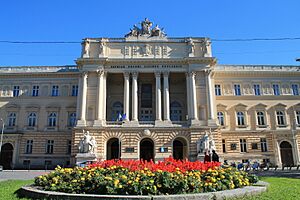
Lviv University is one of the oldest universities in Central Europe. It was founded as a Jesuit school in 1608. Its reputation grew thanks to the work of philosopher Kazimierz Twardowski. The Lwów School of Mathematics made Lviv a "World Centre of Functional Analysis" in the 1930s.
In 1852, the Agricultural Academy opened near Lviv. In 1873, the Shevchenko Scientific Society was founded, which became a major academy of sciences. It focused on Ukrainian studies. When the Soviets took over Lviv in 1939, they closed the Shevchenko society.
Lviv was home to the Scottish Café. In the 1930s and early 1940s, Polish mathematicians from the Lwów School of Mathematics met there to discuss math problems. Famous mathematicians like Stanislaw Ulam and Stefan Banach gathered there. The café building is now the Atlas Deluxe Hotel.
Print and Media
Since the early 1990s, Lviv has been a center for Ukrainian-language publishing. The Lviv Book Forum is the biggest book fair in Ukraine. Lviv is also promoting the use of the Ukrainian Latin alphabet.
Popular newspapers in Lviv include "Vysoky Zamok" and "Ekspres". "Lviv Today" is an English-language magazine about business and entertainment in Lviv. There are 17 regional and national radio stations in the city.
Lviv is home to one of the oldest Polish-language newspapers, Gazeta Lwowska, first published in 1811. Other past publications include Kurier Lwowski and Słowo Lwowskie.
Parks and Green Spaces
Lviv has many parks and public gardens. There are over 20 main recreation parks, three botanical gardens, and 16 natural monuments. These offer great places to relax and enjoy nature. Each park has its own unique character and history.
- Ivan Franko Park is the oldest park in the city. It has three-hundred-year-old oak and maple trees.
- Bohdan Khmelnytsky Culture and Recreation Park is a well-organized modern green area. It has a concert hall, stadium, and a Ferris wheel.
- Stryiskyi Park is considered one of the most beautiful parks in the city. It was designed in the 1870s and has over 200 types of trees and plants. It is known for its rare trees and a pond with swans.
- Znesinnia Park is great for cycling, skiing, and hiking.
- Shevchenkivskyi Hai has an open-air museum of Ukrainian wooden architecture.
- High Castle Park is on the highest hill in the city (413 meters or 1,355 feet). It offers great views of Lviv.
- Zalizni Vody Park is named after its springs with high iron content. It is a favorite spot for locals.
- Lychakivskyi Park was founded in 1892. It includes a botanical garden.
Sports in Lviv
Lviv was an important sports center in Central Europe and is seen as the birthplace of Polish football. The first Polish ice-hockey match took place here in 1905. Two years later, the first ski-jumping competition was held nearby. The first Polish basketball games were also organized in Lviv's gymnasiums.
Football in Lviv
The first known official goal in a Polish football match was scored in Lviv on July 14, 1894. The first Polish professional football club, Czarni Lwów, opened here in 1903. Another club, Pogoń Lwów, won the Polish football championship four times (1922, 1923, 1925, and 1926).
Lviv now has several professional football clubs. Two teams, FC Rukh Lviv and FC Lviv, play in the Ukrainian Premier League. FC Karpaty Lviv, founded in 1963, was historically the city's largest club.
Sports Stadiums
- Ukraina Stadium
- Arena Lviv is a new football stadium that hosted games for the Euro 2012 Championship. It is the home ground of FC Lviv.
- SKA Stadium is used for football and motorcycle speedway.
Other Sports
Lviv is known for its chess school. Famous grandmasters like Vasyl Ivanchuk and Anna Muzychuk have lived there. Lviv Speedway is a motorcycle speedway team. Lviv also tried to host the 2022 Winter Olympics but withdrew its bid in 2014.
Tourism in Lviv
Lviv is a major tourist destination in Ukraine. It has many hotels, cafes, and restaurants, and free Wi-Fi in the city center. The city saw a 40% increase in tourist visits in the early 2010s, one of the highest rates in Europe.
Popular tourist spots include the Old Town and Market Square (Ploshcha Rynok). The Market Square is a large square in the city center where the City Hall is located. Other famous places are the Black House, Armenian Cathedral, and the Dormition Church.
You can also visit the St. Peter and Paul Church, the Korniakt Palace, and the Latin Cathedral of the Assumption of Mary. Don't miss St. George's Cathedral, the Dominican Church, and the Chapel of the Boim family. The Lviv High Castle offers great views of the city. Other popular spots include the Lychakivskiy Cemetery, Svobody Prospekt (Lviv's central street), the Lviv Theatre of Opera and Ballet, the Potocki Palace, and the Bernardine Church.
- Landmarks and points of interest
-
View of Old Town, a UNESCO World Heritage Site
Public Transport in Lviv
Lviv's first horse-drawn tram lines opened on May 5, 1880. Electric trams were introduced on May 31, 1894. The tram tracks are narrow-gauge, which is unusual but helps them fit through the city's old, narrow streets.
The Lviv tramway system now has about 220 cars and 75 kilometers (47 miles) of track. Many tracks were rebuilt around 2006. A tram or trolleybus ticket cost 5 UAH in February 2019. You can buy tickets from the driver.
After World War II, trolleybuses replaced tram lines in the city center. New lines were added to reach the new apartment blocks on the city's edges. The network now has about 100 trolleybuses. The public bus network uses mini-buses and larger buses. As of January 1, 2013, the city had 52 public bus routes.
Railways in Lviv
Lviv is a major railway hub with nine railway lines connecting local and international services. The first train arrived in Lviv on November 4, 1861. The main Lviv Railway Station, built in 1904, was considered one of the best in Europe.
Before World War II, Lwów was an important hub for the Polish State Railways. Many trains left daily, connecting Lwów with major cities in Poland and other European cities like Berlin and Budapest.
Today, several trains cross the nearby Polish–Ukrainian border. There are also good connections to Slovakia and Hungary. Many routes have overnight trains with sleeping areas. Lviv railway is often called the main gateway from Ukraine to Europe.
Air Transport in Lviv
Aviation in Lviv began in 1884 with the Aeronautic Society. In 1909, the Awiata Society was founded. In 1913–1914, two brothers built the first Polish-made airplane. On November 5, 1918, the first flight under the Polish flag took off from Lviv's Lewandówka airport.
The Lviv Danylo Halytskyi International Airport (LWO) is located 6 kilometers (4 miles) from the city center. In 2012, the airport was renovated for the 2012 UEFA European Football Championship. A new terminal and other improvements were made. You can get to the city center from the airport by bus.
Bicycle Lanes in Lviv
Cycling is a new but growing way to get around Lviv. In 2011, the city approved a plan to build 270 kilometers (168 miles) of cycle lanes and tracks by 2019. Lviv has a cycling advisor who helps with this plan.
In 2015, the first stations for a new bike-sharing system called Nextbike were set up. New bike lanes are also being built, making Lviv the most bike-friendly city in Ukraine. The Lviv City Council plans to build a complete cycling network by 2020.
Education in Lviv
Lviv is an important education center in Ukraine. The city has 12 universities, 8 academies, and many smaller schools. It also has eight institutes of the National Academy of Science of Ukraine and over forty research institutes. These include institutes for space research, cell biology, and ecology.
In Soviet times, Lviv was where software for the Lunokhod space program was developed. Technology for the Venera probes and the Buran space shuttle was also developed here.
Lviv has a strong scientific community. It is the fourth city in Ukraine for the number of scientists and research organizations. Over 100,000 students study in more than 50 higher education places each year.
Universities in Lviv
- Ivan Franko National University of Lviv
- Lviv Polytechnic
- Danylo Halytsky Lviv National Medical University
- Lviv Stepan Gzhytsky national university of veterinary medicine and biotechnologies
- National Forestry Engineering University of Ukraine
- Ukrainian Catholic University
- The Lviv National Academy of Arts
- Lviv National Music Academy
- Lviv National Agrarian University
- Lviv State University of Physical Training
- Lviv Academy of Commerce
- Lviv State University of Life Safety
- Lviv State University of Internal Affairs
Notable People from Lviv
Many famous people have come from Lviv, including artists, scientists, and athletes.
International Connections
Twin Towns and Sister Cities

Lviv is connected with many cities around the world as "twin towns" or "sister cities":
| City | State | Year |
|---|---|---|
| Winnipeg | 1973 | |
| Corning | 1987 | |
| Freiburg im Breisgau | 1989 | |
| Rzeszów | 1992 | |
| Rochdale | 1992 | |
| Budapest | 1993 | |
| Rishon LeZion | 1993 | |
| Przemyśl | 1995 | |
| Kraków | 1995 | |
| Novi Sad | 1999 | |
| Kutaisi | 2002 | |
| Wrocław | 2003 | |
| Łódź | 2003 | |
| Banja Luka | 2004 | |
| Lublin | 2004 | |
| Tbilisi | 2013 | |
| Parma | 2013 | |
| Vilnius | 2014 | |
| Chengdu | 2014 | |
| Cannes | 2022 | |
| Würzburg | 2023 | |
| Katowice | 2023 | |
| Reykjavík | 2023 | |
| Pula | 2023 | |
| Aarhus | 2023 | |
| Tartu | 2024 | |
| Mechelen | 2024 |
Partner Cities
Lviv also has cooperation agreements with other cities:
| City | State | Year |
|---|---|---|
| Kobe | 2023 | |
| Frankfurt | 2024 |
More About Lviv
- List of Leopolitans
- Polish football clubs started in Lviv: Pogoń Lwów, Czarni Lwów, Lechia Lwów, Hasmonea Lwów
- Great Suburb Synagogue
- Win with the Lion
- Wanda Mejbaum-Katzenellenbogen
- Banks in Lviv
- Lviv during the Middle Ages
See also
 In Spanish: Leópolis para niños
In Spanish: Leópolis para niños


